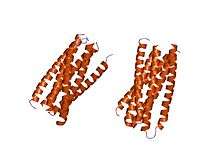Gp41
| GP41 | |||||||||
|---|---|---|---|---|---|---|---|---|---|
 Example crystal structures of HIV-1 envelope glycoprotein Gp41 | |||||||||
| Identifiers | |||||||||
| Symbol | GP41 | ||||||||
| Pfam | PF00517 | ||||||||
| InterPro | IPR000328 | ||||||||
| SCOP | 2siv | ||||||||
| SUPERFAMILY | 2siv | ||||||||
| |||||||||
Gp41 also known as glycoprotein 41 is a subunit of the envelope protein complex of retroviruses, including human immunodeficiency virus (HIV). Gp41 is a transmembrane protein that contains several sites within its ectodomain that are required for infection of host cells.
Gene and post-translational modifications
The env gene codes for gp160, a precursor, which is extensively glycosylated and proteolytically cleaved into two subunits gp120 and gp41 (this protein) by furin, a host cellular protease.
Function
In a free virion, the fusion peptides at the amino termini of gp41 are buried within the envelope complex in an inactive non-fusogengic state that is stabilized by a non-covalent bond with gp120. Gp120 binds to a CD4 and a co-receptor (CCR5 or CXCR4), found on susceptible cells such as Helper T cells and macrophages.[1] As a result, a cascade of conformational changes occurs in the gp120 and gp41 proteins. The core of gp41 folds into a six helical bundle structure exposing the previously hidden gp41 fusion peptides which then assist in the fusion with the host cell.[2] The activation process occurs readily which suggest that the inactive state of gp41 is metastable and the conformational changes allow gp41 to achieve its more stable active state.
As a drug target
The interaction of gp41 fusion peptides with the target cell causes a formation of an intermediate, pre-hairpin structure which bridges and fuses the viral and host membranes together. The pre-hairpin structure has a relatively long half-life which makes it a target for therapeutic intervention and inhibitory peptides.[3]
Enfuvirtide (also known as T-20) is a fusion inhibitor drug that binds to the pre-hairpin structure and prevents membrane fusion and HIV-1 entry to the cell. The vulnerability of this structure has initiated development towards a whole spectrum of fusion preventing drugs.[4] A variety of naturally-occurring molecules have also been shown to bind gp41 and prevent HIV-1 entry.[5]
References
- ↑ Chan DC, Kim PS (May 1998). "HIV entry and its inhibition". Cell. 93 (5): 681–4. doi:10.1016/S0092-8674(00)81430-0. PMID 9630213.
- ↑ Buzon V, Natrajan G, Schibli D, Campelo F, Kozlov MM, Weissenhorn W (May 2010). "Crystal structure of HIV-1 gp41 including both fusion peptide and membrane proximal external regions". PLoS Pathog. 6 (5): e1000880. doi:10.1371/journal.ppat.1000880. PMC 2865522
 . PMID 20463810.
. PMID 20463810. - ↑ Lalezari JP, Henry K, O'Hearn M, Montaner JS, Piliero PJ, Trottier B, Walmsley S, Cohen C, Kuritzkes DR, Eron JJ, Chung J, DeMasi R, Donatacci L, Drobnes C, Delehanty J, Salgo M (May 2003). "Enfuvirtide, an HIV-1 fusion inhibitor, for drug-resistant HIV infection in North and South America". N. Engl. J. Med. 348 (22): 2175–85. doi:10.1056/NEJMoa035026. PMID 12637625.
- ↑ Root MJ, Steger HK (2004). "HIV-1 gp41 as a target for viral entry inhibition". Curr. Pharm. Des. 10 (15): 1805–25. doi:10.2174/1381612043384448. PMID 15180542.
- ↑ Eade CR, Wood MP, Cole AM (2012). "Mechanisms and modifications of naturally occurring host defense peptides for anti-HIV microbicide development.". Curr. HIV. Res. 10 (1): 61–72. doi:10.2174/157016212799304580. PMID 22264047.
External links
- gp41 Envelope Protein, HIV at the US National Library of Medicine Medical Subject Headings (MeSH)